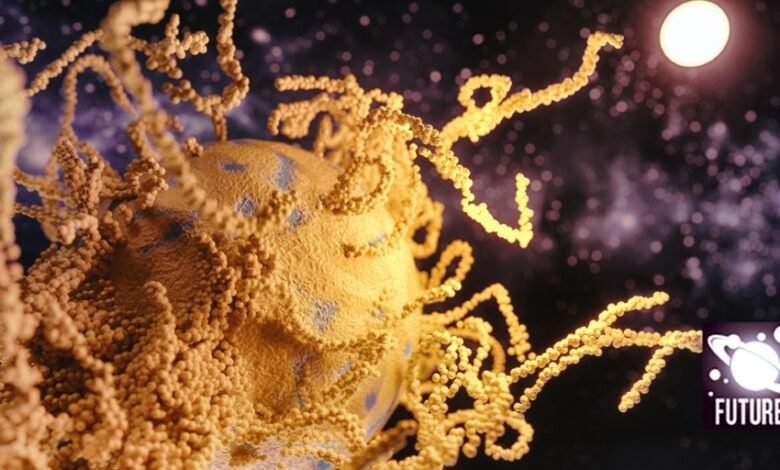
MANNA. Food of the gods. The acronym should have raised red flags from the start. Mycogenic ambrosis through neoplastic neurotrophic augmentation was a mouthful — so to speak — but MANNA was tailor-made for a public-relations campaign.
When the outbreak started, I was a consultant, helping multinational corporations handle the logistics of security and contact tracing in the wake of the latest respiratory virus.
From the moment it showed up in the food courts of international airports, MANNA-mania took root in our consciousness. Sure, the pundits invited talking heads in lab coats onto their news shows, but mostly they made quips about the latest Pumpkin Spice variant.
We struggled to frame a counterargument, and could you blame us? The fungus that caused MANNA politely avoided oozing from our mouths and noses. The infected did not shamble, shuffle, growl or make clicking noises. They scrupulously avoided fMRI and PET scans and scarcely mentioned brains at all.
The closest approximation they managed to a zombie horde was when the smoothie kiosk ran low.
MANNA, or ambrosia as the foodies called it, spread like any cultural fad. When doctors started noticing fungal growths in the nucleus accumbens and other ‘addiction centres’ of the brain, the media collectively shrugged and muttered something about chocolate being addictive, too.
Read more science fiction from Nature Futures
The first attempts at bans, prompted by the occasional supply shortage and price hike, met with ferocious opposition from libertarians and the eco-friendly left. The resilient MANNA fungus grew in rugged terrain and on garbage heaps, creating a new cash crop.
It should have been obvious in retrospect. Humans had long since become an acquisitive species instead of an inherently predatory one. The way to our hearts is through our stomachs, and we prefer quiet contentment to quiet desperation whenever life gives us the chance.
The fungus’s natural cocktail of psychoactive compounds brought tranquillity and contentment. They passed readily into breast milk, producing a generation of perpetually sedate children.
I wrote an editorial warning that we would become more sedentary, face obesity and suffer other health problems unless we came to terms with MANNA’s effects. The article garnered a few dozen comments, mostly about fat-shaming and the audacity of judging young parents in a complex world.
Around this time, I said to hell with it and bought stock in an up-and-coming food manufacturer serving emerging markets. Once MANNA became the staple food in India, China and Brazil, I didn’t have to work anymore.
I spent my leisure time watching people and the markets. That was when I noticed that viral and bacterial infection rates had plummeted, faster than you’d expect from the decline in air travel. Insurance-company profits soared. People weren’t getting sick, and they weren’t dying. Fungal growth on the inside of the arterial walls consumed excess nutrients, giving modern humans a svelte physique underneath the irregular fungal growths that covered their bodies.
Did you know that the root of the word ambrosia is from the Greek ambrotos, meaning immortal? Fungal colonies can live, quietly, for thousands of years. The MANNA infection is patient. Death and violence put a crimp in its life cycle.
I did not appreciate the depths of its character until I saw the MANNA-native children grow up. They did not bully others or seek attention. They lived in groups, talking in whispers whenever within earshot of people like me.
Classrooms had fewer children with each passing year. One day, they will sit empty, abandoned, but the new generation will not sit idle. Fungi love patterns, even more than animals do.
I leave them be, knowing how far the kingdom of fungi will go to protect itself, survive and endure.
Generation M, as we old folks like to call them, will not fight wars or pursue vain ambitions. They form communities around the cultivation and processing centres and within clusters of windowless dwellings.
As near as I can tell from their efforts at Internet porn, they mate using olfactory cues, following biochemical signals that mean nothing to me. Then again, love has always been something of a mystery. Why should fungal love be any different?
I started ordering my food from MANNA-free organic farms. The robots run those now, on account of the labour shortage. The fungus prefers moist, dark areas, and the myco-Morlocks prefer to spend time with their machines. They shy away from agricultural work on the surface.
As for me, I enjoy the quiet beaches. I walk the streets of cities teeming with plants, birds, small mammals and drones. I see determination and despair on the faces of the uninfected when I pass them on the street. They want life back the way it was, but they lack the numbers to compete. I don’t mind this new world. The air is clear, the nights cool, and the stars more beautiful than ever.
Sometimes, I feel more kinship with the bots that keep the old cities going out of inertia. From them, I learn that the younger generation have robots of their own underground, built in their image. They too dream of the stars.
The first of their interstellar ships will leave within the decade. I can’t go, of course, lacking the resilience and longevity for the trip.
Or maybe I’ll go in the cargo hold, waiting to be consumed as part of the fungal life cycle. It beats sinking into a tar pit or waiting for an asteroid strike. There are worse ends for a species than becoming food for the gods.
Source link




